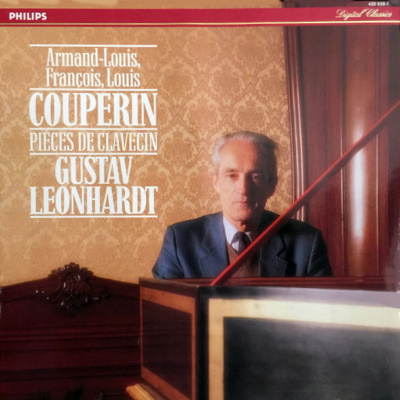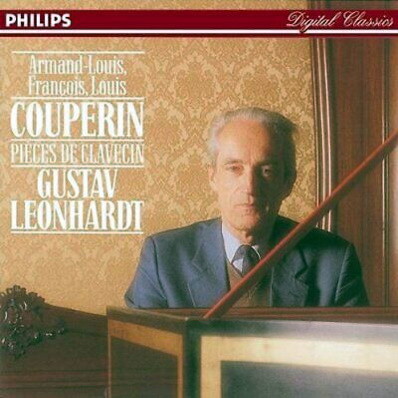 |
|
1 LP -
420 939-1 - (p) 1988
|
 |
| 1 CD -
420 939-2 - (p) 1988 |
|
PIÈCES DE
CLAVECIN
|
|
|
|
|
|
|
|
| Louis COUPERIN (c.1626-1661) |
Suite
in D minor
|
|
20' 21" |
|
|
-
Prélude
|
5' 52" |
|
1
|
|
-
Allemande |
3' 18" |
|
2
|
|
-
Courante |
1' 12" |
|
3
|
|
-
Courante |
1' 26" |
|
4 |
|
-
Sarabande
|
1' 53" |
|
5
|
|
-
Sarabande |
2' 02" |
|
6 |
|
-
La pastourelle
|
1' 30" |
|
7
|
|
-
Chaconne |
3' 08" |
|
8
|
| François COUPERIN (1688-1733) |
"L'art
de toucher le clavecin", Préludes: |
|
13' 22" |
|
|
-
No. 1 in C
|
1' 11" |
|
9
|
|
-
No. 2 in D minor
|
1' 39" |
|
10
|
|
-
No. 3 in G minor |
0' 51" |
|
11 |
|
-
No. 4 in F |
1' 34" |
|
12 |
|
-
No. 5 in A |
2' 38" |
|
13 |
|
-
No. 6 in B minor |
1' 31" |
|
14 |
|
-
No. 7 in B flat |
2' 34" |
|
15 |
|
-
No. 8 in E minor |
1' 23" |
|
16 |
|
Pièces de
Clavecin - Troisième Livre, 15°
Ordre |
|
20' 10" |
|
|
-
La régente ou la Minerve
|
5' 09" |
|
17
|
|
-
Le dodo ou l'Amour au berceau
|
3' 52" |
|
18
|
|
-
L'évaporée
|
1' 46" |
|
19
|
|
-
La douce et piquante
|
2' 59" |
|
20 |
|
-
Les vergers fleuris
|
3' 34" |
|
21 |
|
-
La princesse de Chabeuil ou la muse
de Monaco
|
2' 50" |
|
22 |
| Armand-Louis COUPERIN (1727-1789) |
Pièces
de Clavecin |
|
7' 15" |
|
|
-
L'intrépide |
1' 56" |
|
23 |
|
-
Rondeau |
2' 49" |
|
24 |
|
-
L'arlequine ou la Adam
|
2' 23" |
|
25 |
|
|
|
|
|
Gustav Leonhardt,
Harpsichord (built by Martin Skowroneck
of Bremen after a French model of the late
seventeenth century)
|
|
|
|
|
|
Luogo
e data di registrazione |
|
Haarlem (The
Netherlands) - Maggio 1987
|
|
|
Registrazione: live
/ studio |
|
studio |
|
|
Artist and
reppertoire production
|
|
Rupert Fäustle
|
|
|
Recording producer |
|
Mike Bremner
|
|
|
Engineer |
|
Ko Witteveen
|
|
|
Art direction
|
|
George Cramer
|
|
|
Prima Edizione LP |
|
Philips | LC 0305 |
420 939-1 | 1 LP - durata 61' 36"
| (p) 1988 | DIGITAL
|
|
|
Edizione CD |
|
Philips | LC 0305 |
420 939-2 | 1 CD - durata 61'
36" | (p) 1988 | DDD |
|
|
Cover Art
|
|
Photo by Fernando van
Teylingen
|
|
|
Note |
|
-
|
|
|
|
|
Though not as
numerous as the Bach clan,
the Couperin family was
remarkable in producing a
dozen professional musicians
who occupied important
positions in seventeenth and
eighteenth-century France.
More than half of them
(including two women) were
in the royal service, and
over a period of 170 years
seven were organists at St.
Gervais, in Paris.
The first Couperin to be
appointed to the splendid
organ there was Louis
(c.1626-1661). He had
attracted the attention of
the family's landowning
neighbour Chambonnières
(then court harpsichordist),
who took him to Paris in
1654 and was instrumental in
placing him both at St.
Gervais and in the Chapel
Royal. None of his music
serms to have been published
during his lifetime, but his
keyboard compositions were
eagerly copied out by
several of his
contemporaries. Some 120
harpsichord pieces by him
have survived in the most
important source, dance
movements of the same kind
(allemandes, courantes,
etc.) are grouped by key,
but suites can be arranged
from these according ta
taste. although
improvvisatory "unméansured"
preludes (i.e. without any
indication of rhythm) had
previously been written for
the lute. Louis was the
first to adopt this style
for the harpsichord: the
present example is one of
his few to contain also a
rhythmic ricercare-like
central section. The
"wonderful dissonances" (in
the words of a writer of the
period) that enriched his
music are most plaintly to
be heard in the second
Sarabande and the dark-toned
Chaconne (which is a rondeau
with four episodes).
His nephew François
(1668-1733), the greatest of
the Couperins - he was
universally admired, and
known as "Le grand" even in
his lifetime - was ennoble
before the age of 30 by
Louis XIV, to whose chldren
he was music-master. His
"L'art de toucher le
clavecin" (1716), besides
providing invaluable
information about keyboard
fingering, phrasing, and
ornamentation of the time,
contains eight very fine
preludes, several of which
(particularly the first)
adopt the style brisé of
lute technique: four (Nos.
1, 2, 4 and 5), although
"meansured" for euse of
reading, were specifically
directed to be played with
rhythmic freedon. His major
contribution to harpsichord
literature, however, was his
27 Ordres (suites) of binary
dance movements, rondeaux or
chaconnes, with picturesque
or fanciful titles -
including people, places,
objects, or character
studies such as "La doucer"
or "L'évaporèe" (The giddy
girl). "Le dodo" is based on
a nursery melody. "La
princesse de Chabreuil" is
named for a daughter of
François's patron the Prince
of Monaco.
The St. Gervais post was to
cost armand-Louis
(1723-1789) - François's
second cousin - his life,
for after serving there for
40 years he was knocked down
by a horse and killedwhithin
hurryng there from vespsers
at the Chapel Royal, where
he had been officiating. He
published little keyboard
music apart from his "Livre
de clavecin" (1751). The
three pieces here from it
are all in the old rondeau
form: the energetic refrain
of "L'intrèpide" in strongly
chordal, and its unusually
long second episode includes
several modulations; the
refrain of the more sober
Rondeau in B flat consists
of a chain of suspensions
which reappears note for
none is the dominant key in
the first episode, and the
title of "L'Arlequine,"
together with its madcap
gaiety and caprice, brand it
almost certainly as a
portrait of a contemporary
eany.
Lionel
Salter
|
  |
|
|